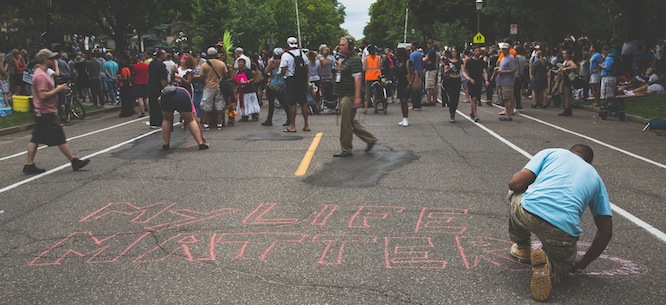After Dallas
After Dallas
To ask what the future of Black Lives Matter has to do with Dallas is to believe that the killing of police officers is bound up in the actions of the movement. But this tragedy won’t end the movement, because the movement did not cause this tragedy.

The week that opened with the celebration of Independence Day in the United States, closed with a painful and sober reminder that all are not truly free. Over the course of five days, we know that at least seventeen people were killed by police in states from Oregon to South Carolina. We also know that after protesters took to the streets in Dallas in the names of two of the victims—Alton Sterling and Philando Castile—a gunman decided to target police officers patrolling the demonstration. By the early morning of Friday, July 8, five police officers had been killed and the attacker was dead at the mechanized hands of a robotic bomb.
Within moments of the Dallas officers’ deaths, media outlets were asking: what’s next for Black Lives Matter? Will the final death count include this movement? The New York Times presented two versions of a story with the first headline declaring: “Strides of Black Lives Matter Halt in an Instant,” later changed to, “Black Lives Matter Was Gaining Ground. Then a Sniper Opened Fire.”
Embedded in all of these questions and statements about the fate of BLM are ahistorical and misinformed assumptions that sustain vitriol and hostility toward citizens demanding accountability from police and the state. To ask what BLM has to do with Dallas is to believe that the killing of police officers is bound up in the actions of the movement. Even after the shooter, Micah Xavier Johnson, was identified as the lone assailant and it was clear that he was a former member of the military and not affiliated with any activist group, BLM was constantly called upon to answer for his actions. As BLM founder Alicia Garza made clear in an interview about the police killings, “Black Lives Matter has never, ever called for the murder of police officers. What we have said over and over again is that it is time in this country for policing to be accountable, transparent, and responsible. That’s not rhetoric. That is what communities in the United States want to see from the people who protect and serve them.”
As BLM celebrates its third birthday this week—having been founded in the aftermath of George Zimmerman’s acquittal in 2013 of the killing of teenager Trayvon Martin—this is a fitting opportunity for the public to be educated and reminded of how much this movement has weathered and grown. BLM, not unlike the spirit of people of color, was supposed to break long ago. The movement has proven that its greatest weapon is not only resistance, but also survival.
In December 2014 critics of BLM tried to blame the deaths of two New York City police officers on the movement, though it was clear that the killer Ismaaiyl Brinsley was not affiliated with any activist group. Months later, in March 2015, when two police officers were shot in Ferguson, Missouri—the key site for most of the world’s introduction to BLM—organizers did not retreat from the Midwestern town or end their calls for justice for Michael Brown. These tragedies did not end the movement, because the movement did not cause these tragedies.
BLM has also sustained its organizing, protest, and outreach across a wide array of state-related matters—including education, labor, gender equality, and the rights of queer people—despite targeted efforts to destabilize the movement. The arrests and aggressive prosecution of citizens who have videotaped police misconduct and protesters has not deterred organizing or reduced the number and scope of actions across the country.
BLM, despite clearly articulating its aims and commitments, all too often serves as a shorthand for the grievances of people of color, the bad object in the nostalgic renderings of the glory days of the civil rights movement, or a Rorschach test for white fragility. Regardless of the cacophony that has surrounded BLM over the past three years, the ability to declare that Black Lives Matter and to demand, “Stop killing us” answers any and all questions about its viability.
Perhaps this moment is better used to ask the state, or the entire nation, about its own future. How many more deaths would we like to watch on computer screens? How many more police officers will evade prosecution for killing people of color? How many more children would we like to hear eulogize their lost parent and ask for peace? Do you think you can survive?
Marcia Chatelain is assistant professor of history at Georgetown University. She is also the author of South Side Girls: Growing Up in the Great Migration (Duke University Press, 2015.)






